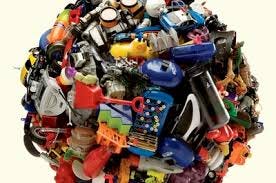This month we’re focusing on one of the most important issues we’re all facing today, but not enough people are talking about: our urgent need for creating new solutions. Not just for software or AI, but for everything in our lives, our teams and our communities. And we’re talking about where the most important innovations come from (hint: probably not where you thought).
This month is also the re-launch of Everybody Innovates Here, my book that explains why so many of our innovation and entrepreneurship ecosystems fail to move the needle for our communities, and what we have to do to make them work the way they should. You’ll see posts and videos about Everybody Innovates Here across your socials this month. And Change Maker (paid) subscribers to Future Here Now will receive a code for a hefty discount on the book and on workshops!
This book never got the daylight it deserved thanks to COVID, and I’m thrilled to be able to share it. If you are not a Change Maker subscriber, you can get that discount code too – all you have to do is sign up before July 25!
And to sweeten the deal, I’ll give you 25% off that subscription – but don’t delay. This won’t last.
Years ago, I had a mentor who told me,
“Entrepreneurs are like cockroaches. All you have to do is put out a pile of rich food, and they will come and grab what they need,”
I repeated that line for years before I realized that it was totally wrong. Well, mostly wrong.
It’s not wrong if you (the entrepreneur) have enough extra time, and money, and connections, and formal education, and literacy, and information access, to go digging through the pile to find what you need.
But for the overwhelming majority of people who could be entrepreneurs, that pile looks impossible. They might grab one bit, try it out, fight there way through it. And when they’re done? How do they have any idea which thing to grab next?
Most of our entrepreneurship support “ecosystems” – from downtown districts to start up programs – aren’t ecosystems at all. They’re piles of stuff. A random assortment of programs and classes and accelerators and pitch nights and so on that don’t connect to each other. That don’t follow any logical progression. Piles that leave most entrepreneurs floundering, guessing, as to what they need next and where to find it and how to use it. And since the overwhelming majority of potential entrepreneurs don’t have enough extra time, and money, and connections, and formal education, and literacy, and information access, to go digging through the pile,
They don’t.
They give up. At best, they settle for a scraping by survival that doesn’t generate the wealth, the new jobs, and the impact that were held up to funders as the justification for that program or incubator or pitch night in the first place.
An actual ecosystem is not just a pile of animals and fungi and microbes and plants and whatever. They didn’t show up together by accident, because someone thought it would be cool to have a mushroom there.
An ecosystem exists because of the interdependencies between them. The mushroom evolved to capitalize on the type of microbes in that particular type of soil. The plants grow in that location because of the nutrients created by the mushroom breaking down fallen trees. The system in the ecosystem is the reason why anything works. That mushroom would not exist in different soil or climate or type of tree that falls down.
Our ecosystems fail the overwhelming majority of our potential entrepreneurs because they’re not systems. They’re piles.
And it turns out that only the most privileged of cockroaches can find what they need in the pile.
Tomorrow we’ll see a few Signals of the lack of system in our ecosystems. And next week we’ll explore how we can change our frame of reference to enable real entrepreneurial growth.


